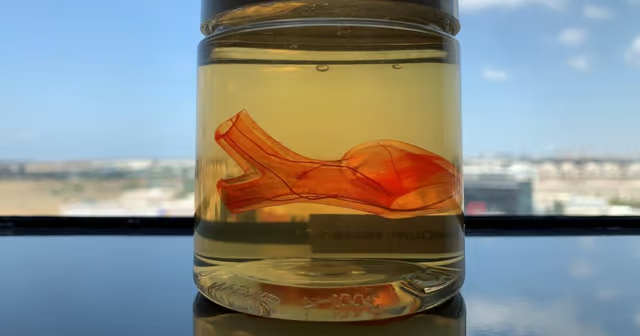3D Systems, a leading U.S. additive manufacturing company, has announced plans for a Regenerative Tissue Program (RPT). The strategic initiative aims to develop and commercialize bioprinted human tissue, building upon 3D Systems expertise in Healthcare from in-house products such as Virtual Surgical Planning (VSP) and recent acquisitions, including the $400M purchase of Volumetric Biotechnologies.
Since being appointed CEO, Dr. Jeffrey Graves has clearly defined his vision for 3D Systems to lead in the medical vertical. On an earnings call last year, Graves singled out medical 3D printing for “patient solutions” as an “increasingly exciting market” where 3D Systems is “a clear leader.” Graves continued with optimism when he unveiled the new tissue program, claiming that 3D Systems development of “patient-specific human tissues” will “dramatically alter how patient care is delivered.”

Potential to produce patient-specific regenerative breast tissue
The Regenerative Tissue Program draws on experience and expertise gained in solid organ development to tackle non-organ applications. Dr. Martine Rothblatt detailed a separate strategy focused on 3D printing organs at last year’s LIFE ITSELF conference. Rothblatt, CEO of 3D Systems’ partner, United Therapeutics, announced an ambitious goal – 3D printed lungs cleared for human trials in under five years.
The first RPT product under development relates to patient-specific regenerative breast tissue (RBT™). Katie Weimer, vice president of regenerative medicine at 3D Systems, says RBT “sets us apart” from competitors. Weimer further sees the program as opening “tremendous opportunities in providing a unique solution to breast reconstruction surgeons and patients.”
Targeting breast tissue meets a growing demand. According to the World Health Organization, the breast cancer five-year post-diagnosis survival rate has increased to over 90% in high-income countries. Consequently, the need for long-term patient-specific regenerative breast reconstruction is rising. In contrast, current options for tissue reconstruction after mastectomy often prove unsatisfactory, with complications and additional procedures frequently required following surgery.
3D Systems says that by using 3D modeling and 3D bioprinting technology alongside its Virtual Surgical Planning (VSP) system, it will be able to design and produce bio-integrative scaffolds that match the patient’s anatomy and physiology. Patients will be able to receive personalized regenerative soft tissue, improving long-term outcomes with an optimized patient experience.
3D Systems explains it has already conducted a good deal of research into producing patient-specific regenerative soft tissue, guiding its efforts and providing evidence that these claims are feasible in practice. The company states that over the past 12 months, multiple large animal studies have been conducted, which give a proof-of-concept regarding the bio-integrative scaffolds that enable body fat regeneration. These scaffolds are constructed from biocompatible materials and possess tunable material properties. The company has also demonstrated an ability to connect scaffolds directly to the human vasculature. In effect, this will allow for personalized breast-size human-tissue reconstructions.
The benefits of additive technology are not limited to these applications, with Weimer saying that “this work will be expanded into future applications such as lumpectomies, breast augmentation, and facial implants.”
Advanced healthcare at 3D Systems
A focus on advanced regenerative healthcare is familiar to 3D Systems. Their 2021 acquisition of Pennsylvania-based 3D bioprinter developer Allevi marked a distinct step in the direction of regenerative medicine research. The 3D bioprinting and bioinks technology produced by Allevi can be found in over 380 pharmaceutical and medical laboratories worldwide and offers numerous regenerative medicine applications. At the time, Graves expressed his excitement at the “expertise, capabilities, and technologies” provided Allevi, with this acquisition forming a significant part of the company’s four-step growth initiative.
3D Systems built upon this progress in September 2022 when it announced the formation of Systemic Bio. This new 3D bioprinting subsidiary utilizes the technologies developed by Allevi and their Print to Perfusion program. The vascularized 3D scaffolds produced by Systemic Bio can be seeded with healthy and diseased human cells from different organs. This offers a novel drug safety and efficacy testing process, with these cells having already been proven capable of accurately simulating human immune responses. Consequently, Systemic Bio aims to generate $100 million annually in revenue by 2027 by marketing this development as a pharmaceutical drug discovery tool.
3D printing for regenerative medicine
The additive applications to regenerative medicine are not limited to producing bioprinted human tissue. Indeed, a variety of broad uses are being pursued by additive manufacturers within this industry.
Israel-based regenerative medicine specialists CollPlant recently announced that its proprietary 3D bioprinted breast implants have successfully passed the animal testing stage of development. These implants offer a plant-based alternative to collagen by growing recombinant human collagen (rhCollagen) onto genetically-engineered tobacco plants. Utilizing this process, the company has already developed in-house 3D bioprinted breast implants and is looking ahead to human trials and an eventual launch to market.
Moreover, researchers at five Fraunhofer research institutes have sought to develop a unique way of producing patient-specific finger joint implants. This has been achieved by combining AI and 3D printing to turn 2D X-ray images into 3D finger models. This process is part of the ‘FingerKIt’ project, which is said to facilitate the correction of any finger positioning issues.
Subscribe to the 3D Printing Industry newsletter to ensure you keep up with the latest 3D printing news. You can also follow us on Twitter, like our Facebook page, and subscribe to the 3DPI Youtube channel to access more exclusive content.
Are you interested in working in the additive manufacturing industry? Visit 3D Printing Jobs to view a selection of available roles and kickstart your career.
Featured image shows the 3D Systems Healthcare Technology Center. Photo by 3D Printing Industry.


